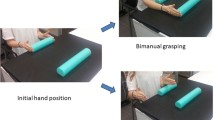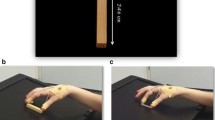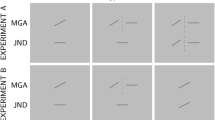Abstract
Visually guided actions toward two-dimensional (2D) and three-dimensional (3D) objects show different patterns of adherence to Weber’s law. In 3D grasping, Just Noticeable Differences (JNDs) do not scale with object size, violating Weber’s law. Conversely, JNDs in 2D grasping increase with size, showing a pattern of scaler variability between aperture and JND, as predicted by Weber’s law. In the current study, we tested whether such scaler variability in 2D grasping reflects genuine adherence to Weber’s law. Alternatively, it could be potentially accounted for by a speed–precision tradeoff effect due to an increase in aperture velocity with size. In two experiments, we modified the relation between aperture velocity and size in 2D grasping and tested whether movement trajectories still adhere to Weber’s law. In Experiment 1, we aimed to equate aperture velocities between different-sized objects by pre-adjusting the initial finger aperture to match the target’s size. In Experiment 2, we reversed the relation between size and velocity by asking participants to hold their fingers wide open prior to grasp, resulting in faster velocities for smaller rather than for larger objects. The results of the two experiments showed that although aperture velocities did not increase with size, adherence to Weber’s law was still maintained. These results indicate that the adherence to Weber’s law during 2D grasping cannot be accounted for by a speed–precision tradeoff effect, but rather represents genuine reliance on relative, perceptually based computations in visuomotor interactions with 2D objects.






Similar content being viewed by others
References
Afgin O, Sagi N, Nisky I, Ganel T, Berman S (2017) Visuomotor resolution in telerobotic grasping with transmission delays. Front Robot AI 4:54
Aglioti S, DeSouza JF, Goodale MA (1995) Size-contrast illusions deceive the eye but not the hand. Curr Biol 5(6):679–685
Baird JC, Noma EJ (1978) Fundamentals of scaling and psychophysics. Wiley, Amsterdam
Evans GB, Howarth E (1966) The effect of grip-tension on tactile-kinaesthetic judgement of width. Q J Exp Psychol 18(3):275–277
Foster RM, Franz VH (2013) Inferences about time course of Weber’s Law violate statistical principles. Vision Res 78:56–60
Freud E, Ganel T (2015) Visual control of action directed toward two-dimensional objects relies on holistic processing of object shape. Psychon Bull Rev 22(5):1377–1382
Freud E, Macdonald SN, Chen J, Quinlan DJ, Goodale MA, Culham JC (2018) Getting a grip on reality: grasping movements directed to real objects and images rely on dissociable neural representations. Cortex 98:34–48
Fukui T, Inui T (2013) How vision affects kinematic properties of pantomimed prehension movements. Front Psychol 4:44. https://doi.org/10.3389/fpsyg.2013.00044
Ganel T (2015) Weber’s law in grasping. J Vis 15(8):18
Ganel T, Goodale MA (2003) Visual control of action but not perception requires analytical processing of object shape. Nature 426(6967):664
Ganel T, Chajut E, Algom D (2008) Visual coding for action violates fundamental psychophysical principles. Curr Biol 18(14):R599–R601
Ganel T, Freud E, Meiran N (2014) Action is immune to the effects of Weber’s law throughout the entire grasping trajectory. J Vis 14(7):11
Ganel T, Namdar G, Mirsky A (2017) Bimanual grasping does not adhere to Weber’s law. Sci Rep 7(1):6467
Goodale MA, Milner AD, Jakobson LS, Carey DP (1991) A neurological dissociation between perceiving objects and grasping them. Nature 349(6305):154
Goodale MA, Jakobson LS, Keillor JM (1994) Differences in the visual control of pantomimed and natural grasping movements. Neuropsychologia 32(10):1159–1178
Heath M, Jazi SD (2015) An inverse grip starting posture gives rise to time-dependent adherence to Weber’s Law: a reply to Ganel et al. (). J Vis 15(6):1-1. https://doi.org/10.1167/15.6.1
Heath M, Mulla A, Holmes SA, Smuskowitz LR (2011) The visual coding of grip aperture shows an early but not late adherence to Weber’s law. Neurosci Lett 490(3):200–204
Heath M, Holmes SA, Mulla A, Binsted G (2012) Grasping time does not influence the early adherence of aperture shaping to Weber’s law. Front Hum Neurosci 6:332
Holmes SA, Heath M (2013) Goal-directed grasping: the dimensional properties of an object influence the nature of the visual information mediating aperture shaping. Brain Cogn 82(1):18–24
Hosang S, Chan J, Jazi SD, Heath M (2016) Grasping a 2D object: terminal haptic feedback supports an absolute visuo-haptic calibration. Exp Brain Res 234(4):945–954
Jakobson LS, Goodale MA (1991) Factors affecting higher-order movement planning: a kinematic analysis of human prehension. Exp Brain Res 86(1):199–208
Jeannerod M (1986) The formation of finger grip during prehension. A cortically mediated visuomotor pattern. Behav Brain Res 19(2):99–116. https://doi.org/10.1016/0166-4328(86)90008-2
Manzone J, Jazi SD, Whitwell RL, Heath M (2017) Biomechanical constraints do not influence pantomime-grasping adherence to Weber’s law: a reply to Utz et al. (2015). Vis Res 130:31–35
Milner AD, Goodale MA (2008) Two visual systems re-viewed. Neuropsychologia 46(3):774–785
Namdar G, Algom D, Ganel T (2018) Dissociable effects of stimulus range on perception and action. Cortex 98:28–33
Ozana A, Ganel T (2017) Weber’s law in 2D and 3D grasping. Psychol Res. https://doi.org/10.1007/s00426-017-0913-3
Ozana A, Ganel T (2018) Dissociable effects of irrelevant context on 2D and 3D grasping. Attent Percept Psychophys 80(2):564–575
Ozana A, Berman S, Ganel T (2018) Grasping trajectories in a virtual environment adhere to Weber’s law. Exp Brain Res 236(6):1775–1787
Schmidt RA, Zelaznik H, Hawkins B, Frank JS, Quinn Jr JT (1979) Motor-output variability: a theory for the accuracy of rapid motor acts. Psychol Rev 86(5):415
Smeets JBJ, Brenner E (1999) A new view on grasping. Mot Control 3(3):237–271. https://doi.org/10.1123/mcj.3.3.237
Smeets JB, Brenner E (2008) Grasping Weber’s law. Curr Biol 18(23):R1089–R1090
Snow JC, Pettypiece CE, McAdam TD, McLean AD, Stroman PW, Goodale MA, Culham JC (2011) Bringing the real world into the fMRI scanner: repetition effects for pictures versus real objects. Sci Rep 1:130
Utz KS, Hesse C, Aschenneller N, Schenk T (2015) Biomechanical factors may explain why grasping violates Weber’s law. Vis Res 111:22–30
Whalen J, Gallistel CR, Gelman R (1999) Nonverbal counting in humans: the psychophysics of number representation. Psychol Sci 10(2):130–137
Whitwell RL, Goodale MA (2013) Grasping without vision: time normalizing grip aperture profiles yields spurious grip scaling to target size. Neuropsychologia 51(10):1878–1887
Whitwell RL, Ganel T, Byrne CM, Goodale MA (2015) Real-time vision, tactile cues, and visual form agnosia: removing haptic feedback from a “natural” grasping task induces pantomime-like grasps. Front Hum Neurosci 9:216. https://doi.org/10.3389/fnhum.2015.00216
Author information
Authors and Affiliations
Corresponding author
Additional information
Publisher's Note
Springer Nature remains neutral with regard to jurisdictional claims in published maps and institutional affiliations.
Rights and permissions
About this article
Cite this article
Ozana, A., Ganel, T. Obeying the law: speed–precision tradeoffs and the adherence to Weber’s law in 2D grasping. Exp Brain Res 237, 2011–2021 (2019). https://doi.org/10.1007/s00221-019-05572-5
Received:
Accepted:
Published:
Issue Date:
DOI: https://doi.org/10.1007/s00221-019-05572-5




